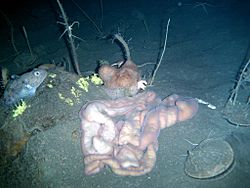Nemertea facts for kids
Quick facts for kids Nemertea |
|
|---|---|
 |
|
| Parborlasia corrugatus from the Ross Sea | |
| Scientific classification | |
| Kingdom: | |
| Subkingdom: | |
| Superphylum: |
Lophotrochozoa
|
| Phylum: |
Nemertea
Schultze, 1851
|
| Synonyms | |
|
Rhyncocoela |
|
Nemertea are a group of invertebrate animals often called ribbon worms or proboscis worms. They are a phylum, which is a major group in the animal kingdom. There are about 1,400 different species of Nemertea. Most of them live in the sea, but some can be found in fresh water. A small number even live on land. You can find them in almost every marine habitat all over the world.
Contents
Body Features of Ribbon Worms
Nemertean worms are usually long and thin. They do not have segments, which means their bodies are not divided into repeating parts like earthworms. They also do not have a true head. However, the front end of their body is often a bit wider than the rest.
The Proboscis: A Special Tool
A unique feature of ribbon worms is their special feeding tool called a proboscis. This is a long, tube-like organ that stays hidden inside their body. When the worm needs to catch food, it can quickly push this proboscis out.
The proboscis is very important for how Nemertea eat. When it's not being used, the proboscis is stored in a long tube inside the worm. This tube can take up a lot of the worm's body length. It sits just above the worm's gut. A strong muscle connects the proboscis to the back of this tube. This muscle pulls the proboscis back inside after the worm has eaten. At the front of the worm, the proboscis tube opens into a small space near the worm's brain. From there, it opens to the outside through a small hole at the very front of the animal.
How Long Can They Be?
Nemerteans come in many different sizes. Some are as small as 5 millimeters (about 0.2 inches). Others can be incredibly long. The European Lineus longissimus can grow to over 30 meters (100 feet) long. Most species, however, are 20 centimeters (8 inches) or less. There are even stories of some specimens reaching 50 or 60 meters long. If true, this would make them the longest animals in the world! For comparison, the longest blue whale ever recorded was 29.9 meters long.
Images for kids
-
A terrestrial nemertean from West Java. The animal is 1.5 cm (0.59 in) long, of which the anterior 1 cm (0.39 in) is visible.
-
A terrestrial Geonemertes sp. on a rotting log, from Mindanao Island, the Philippines
See also
 In Spanish: Nemertea para niños
In Spanish: Nemertea para niños







